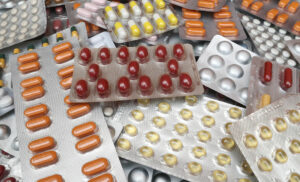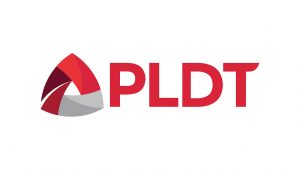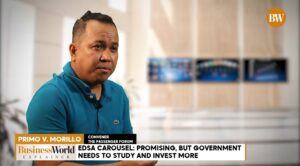High medicine costs expose widening gap between rich and poor Filipinos

By Patricia B. Mirasol, Reporter
KAREN NINA IBAÑEZ-DANAO, a 47-year-old homemaker, knows how expensive life-saving medications can be.
In 2021, she started using Arixtra, an injectable that prevents blood clots, after she was diagnosed with recurring strokes.
“Unfortunately, it’s expensive,” she said in a Facebook Messenger chat. “We spent P60,000 for two weeks’ worth of Arixtra. There was no way we could afford to continue the treatment, so I started raising funds and asked my doctor for cheaper alternatives.”
She switched to oral medication after two months: “I didn’t want to keep raising funds for my medicines because we’ve all been affected by a coronavirus pandemic.”
As the rise in health expenditures outpaces economic growth worldwide, consumers in the Asia-Pacific region without universal health coverage continue to face high out-of-pocket costs, which account for about half of healthcare spending in these countries, according to the Medicines, Technologies and Pharmaceutical Services program of the US Agency for International Development.
“Because pharmaceuticals make up 25% of total health expenditure and, typically, an even larger share of out-of-pocket costs, it is essential to control pharmaceutical costs as a key step toward universal health coverage,” it said in a November 2022 report.
In the Philippines, where a breast cancer patient needs as much as P450,000 to complete 18 treatment cycles, medicine and treatment costs remain an obstacle.
The greatest barrier to medicine access is pricing, according to a report released in January by Takeda, a Japanese pharmaceutical company.
“This is not because specific options aren’t available, but because they are completely out of reach in terms of pricing and are not covered under national insurance schemes,” said Jorge G. Ignacio, a medical oncologist interviewed in the report.
The Philippine Institute for Development Studies (PIDS), a state think tank, also found that the elderly, women, rural and poor Filipinos are more likely to pay out-of-pocket healthcare costs. The Philippine Health Insurance Corp. (PhilHealth) covers only 40% of hospital costs.
Ms. Ibañez-Danao, who spends north of P30,000 a month on medicines out of pocket, says she does not receive help from PhilHealth for medicine expenses.
Mr. Ignacio, who is also chairman of the Philippine General Hospital’s Cancer Institute, said the world is living in an era of precision treatments.
“We look at the genes already and tailor medicines that fit patients in a way that’s more effective,” he said via Zoom. “This would mean that we are going to use medicines that are more technologically advanced, and that would mean higher costs for patients.”
He said the standard treatment of chemotherapy remains effective but adding targeted therapies could mean longer remission time and better survival.
These new therapies are exposing the widening gap between rich and poor Filipinos.
“The rich will be able to live longer and the poor who can’t afford the newer drugs will settle for the older ones that we have,” Mr. Ignacio said.
“Living longer will be a privilege of the richer ones, and that would be terrible,” he said. “We can’t allow things like that to keep on happening. We need to find ways to be able to bridge the gap.”
PRICE CONTROLSMedications were among the most sent items through Philippine mail, according to Roger M. Tumlos, acting manager at the express mail exchange department of the Philippine Post Office in Manila.
His department ensures that prohibited items are caught during the sorting process. “We encounter all sorts of medications, especially those for cancer, because they’re expensive here,” he said during a tour of the post office.
These medicines, which mostly come from India and Pakistan, are released subject to allowed quantities, he pointed out.
Targeted therapies notwithstanding, the situation today is better than it was two decades ago, when few local companies involved in oncology called the shots in pricing, Mr. Ignacio said. Both the Generics Act of 1988 and the Universally Accessible Quality and Cheaper Medicines Act had helped bring down costs, he added.
“Doxorubicin antibiotic used to be P5,000 per vial,” the doctor said. “Now, you can purchase a 50-milligram one for as little as P800 pesos. Cyclophosphamide used to be P900; now, it’s just P300.”
The prices of many of these drugs have gone down due to the influx of medicines from India, South Korea and Indonesia, Mr. Ignacio said.
The Pharmaceutical and Healthcare Association of the Philippines (PHAP) has been lobbying against price limits on medicines. The Universal Health Care Act regulates health goods and services including drug prices.
The law on cheaper medicines recognizes that price regulation is only a reserve instrument, and that an effective competition policy is still a better tool to lower drug prices, PHAP Executive Director Teodoro B. Padilla said in an e-mail.
“The use of price regulation can result in delays in the introduction of new medicines and forces the withdrawal of existing products from the market,” he added.
Mr. Padilla said only 13% of 460 new medicines launched globally from 2012 to 2021 are made available in the Philippines.
“Aside from depriving patients access to newer, lifesaving therapies, price regulation also negatively impacts trade, and has a chilling effect on potential pharmaceutical investors,” he said.
The doctor said PhilHealth’s outpatient drug benefit package and pooled procurement at state hospitals could be improved by increasing government funding for medicines, Mr. Padilla said.
Out-of-pocket spending in countries that have embedded access to medicine programs at all levels of care has fallen to less than 50%, Mr. Padilla said. These include Australia at 47%, South Korea at 42% and Thailand at 9%.
He also said it would help to streamline the review process for prescription drugs that qualify for government procurement and PhilHealth reimbursement.
“The power of price negotiation and pooled procurement, both of which are provided for under the Universal Health Care Act, can be seen with the Health department’s earlier experience in lowering the price of a cancer drug by at least 66% when it procured the medicine in bulk,” he added.
“If an oncology society would buy in bulk, you’d be able to bargain for a cheaper price,” Mr. Ignacio said. “The DoH does this. If we can do it for every kind of medicine, we can get all these drugs at cheaper prices.”
Universal healthcare, which became a law in February 2019, “guarantees equitable access to affordable and quality health services.” It also aims to improve doctor-to-patient ratio, upgrade hospital bed capacities and equipment and set up more hospitals in remote areas.
The program’s success, however, depends on having a healthy population that can pay taxes and PhilHealth insurance premiums, leading the Health department to focus on preventive care.
No one sector can lower drug prices alone, Mr. Ignacio said. “We need a lot of help. If we can put our act together, we’ll be able to solve this burden.”




